6-Figure Sales Copy Templates (+ Full Breakdown)
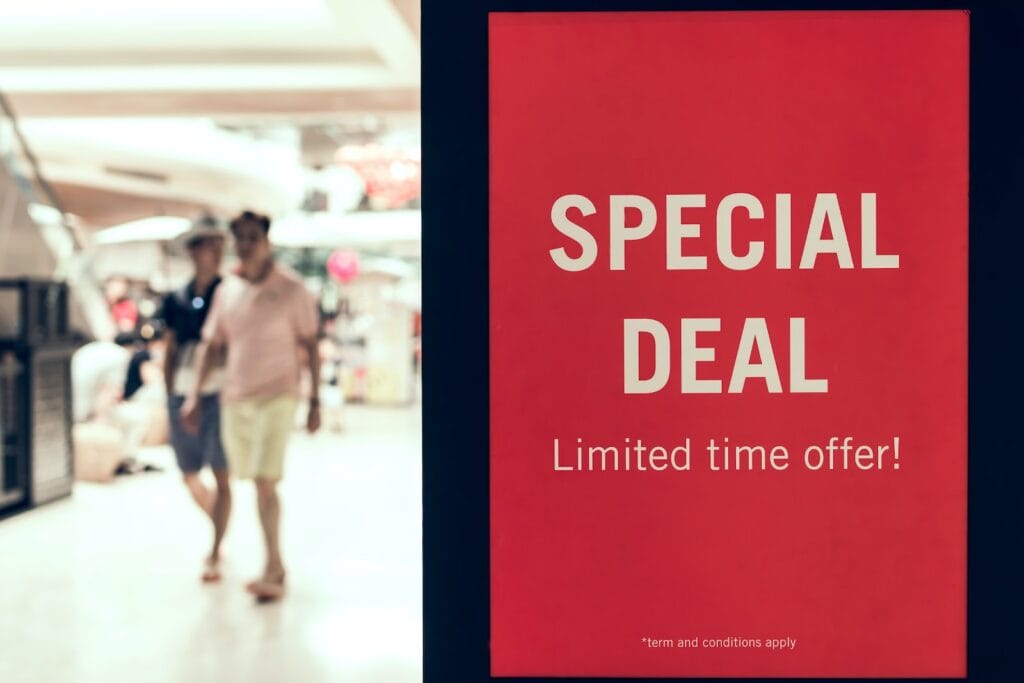

Tell me if this sounds familiar: you sit down in front of that blank Google Doc, fully intending to fill it with words that will touch hearts, change minds, and get customers reaching for their wallets....
And hours later, you’re still there, sitting in front of your computer screen. Or possibly banging your head against the keyboard, depending on your tolerance for frustration.
My friend, what you are experiencing is a wicked case of Blank Page Syndrome (commonly known as writer’s block). But don’t worry — we’ve got the prescription.
In this post, I’m going to walk you through step-by-step on EXACTLY how to overcome writer's block, and create higher-converting copy that ANYONE can use, regardless of skill level (and even give you easy-to-use templates to get started today). Sound good? Let’s get rolling:
There are two pieces that go into writing a great piece of sales copy, whether it’s a landing page, a sales page, an email, or a blog post:
- There’s the structure, or what information goes where — headline here, features and benefits here, opt-in field here.
- And there’s the content, or the actual words you use within that structure to, as the kids say these days, hit your audience right in the feels.
You need BOTH pieces in place in order to write amazing sales copy. And in this post, we’re going to give you the tools you need to get them.
Think about those paintings people make at wine and paint nights. Can you follow the instructions, put the right colors in the right place, and get an end product that looks kind of like the sample that the teacher made? Sure.

But the magic of a work of art is not in what color goes where. That’s just structure.
It’s in the way the colors work together to grab your attention and make you feel something. That’s the je ne sais quoi that makes you stop and look and keep looking. That’s the content.
If you focus just on the structure of the information and not on the actual language that goes into each individual component — you could wind up looking at sales copy like this:
This page follows all the “rules” of landing page structure. But excuse me while I change into my jammies, because that copy is a snooze. I don’t care how much of a tech nerd you are — no one in the history of the planet has said the words, “Boy, I really wish I had a way to synchronize data stores in hybrid and multi-cloud environments.”
In this post, we’re going to give you the structure AND the content that we use at IWT to create sales copy that gets readers to stop, look, keep looking — and then pull out their credit card for six-figure launches.
(Oh, and we made copyable versions of our templates for you here.)
The Structure: Sales copy templates
We’re going to walk through the four main types of sales copy we use at IWT— sales pages, landing pages, sales emails, and blog posts. Each of them is a piece of writing unto itself. But the real power is in how they work together. Think about it like a trail of breadcrumbs. You lay them out one by one — all leading in the direction you want your reader to go: toward buying your product.
Sales page
Your sales page is where you lay out your product, what it does, and why your audience should want it. It’s also where people actually get out their credit card and buy your product.
- Headline
- Introduction
- Offer
- Price
- Testimonials
- Call to action
Read more: The six-part outline the best sales pages have in common
Landing page
A landing page is a short page that you use to generate leads that, when you’re ready, you can turn into sales. This is where you offer your audience something you know they want in exchange for their email address — and the promise of more good content to come straight to their inbox.
- Headline
- Offer
- Benefits
- Opt-in
Read more: Landing pages: Definition, examples, and anatomy
Sales email
Sales emails are emails that you send to your list when you have a product ready for them to buy. Link a series of them together, you get a sales funnel, which you use to funnel people from your email list to your sales page.
- Subject line
- Personal greeting
- Opening line
- Interesting story or lesson
- Call to action
- Personal signoff
- P.S.
Read more: How do I get people to open and read my emails?
Blog post
Blog posts can include everything from exhaustive how-tos and case studies to quick tips and funny personal stories. The number one goal of blog posts is to educate and entertain your audience — but if you’re strategic about the topics you cover and how they tie into your product, they can be a powerful sales tool as well.
- Hook
- Meat
- Call to action
Read more: The 3 parts to a remarkable blog post
Again, templates provide the structure. They tell you what kind of information to put where. That’s step one. Step two is to fill that structure out with the right ideas and language to sell your product to your audience.
Do your research. Talk to your customers. Look at what they’re posting online. Find out the words they use to talk about what they want, what they’re worried about, and what’s standing in their way.
Then, put those exact words into your copy.
For every product we create here at IWT, we spend hours talking to customers before we write a single word of copy.
And we don’t just talk to them: we capture what we learn in a handy tool called the Customer Desire Map.
The Content: Customer Desire Map
The Customer Desire Map is where we capture the actual, exact language our audience uses to talk about their:
- Hopes & Dreams: What your customers want to attain or achieve above all else.
- Pains & Fears: What your customers want to avoid or get away from at all costs.
- Barriers & Uncertainties: The things preventing or getting in the way of your customers attaining what they want.
What does that tell us? It tells us:
- Where our customers are
- Where they want to be
- What’s in their way
AKA the three areas that are the psychological catalysts that jolt readers out of complacency and into taking action.
Here’s a version of the Customer Desire Map for one of the flagship products at our sister site, I Will Teach You to Be Rich: Find Your Dream Job. Find your Dream Job is an old course of ours dedicated to helping students identify, go after, and get a job they love — and pays them what they’re worth.
| Hopes & Dreams | “I just want to wake up and not dread going to work every morning.” “I want a job that I do because I WANT to, not because I HAVE to.” |
| Pains & Fears | “I feel like I’m just going through the motions.” “I don’t want to be here at this same desk 10 years from now.” “Is this it? Do I have to settle forever?” “I’d better get my act together, grow up, do something before I have a family.” “I did what I was supposed to do. I followed all the rules … so why did it end up like this?” |
| Barriers & Uncertainties | “I know I’m supposed to network, but I hate selling myself.” “I didn’t go to a good enough college to get that kind of job.” “I don’t have the right kind of experience to go into that field.” “I don’t even know what my Dream Job IS, let alone how to get it.” |
All of this is great stuff that we can put directly into our sales copy.
So let’s see what it looks like when we take these insights and apply them to the template that we showed you for one of the most essential pieces of sales copywriting you will ever write: the sales page.
Customer Desire Map in action: A six-figure sales page
We’ve already shown you the six-part formula that we use to write stellar sales pages:
- Headline
- Introduction
- Offer
- Price
- Testimonials
- Call to action
Now, let’s look at what happens when we fill that template out with insights pulled from the Customer Desire Map.
This sales page for Find Your Dream Job earned us more than $284,000 when we launched it in 2017 — FIVE YEARS after we first created the course. That just goes to show you how, when you write copy that strikes a nerve and gets at the root of what your audience is thinking and feeling, that work can serve you for years down the line.
We start with a Headline that goes directly after the barriers that we know our customers THINK are standing in their way — and neutralizes them right off the bat.
"I didn’t go to a good enough college to get that kind of job."
"I don’t have the right kind of experience to go into that field."
"I don’t even know what my Dream Job IS."
With our headline, we’re telling readers, “Look — we know you THINK there are all these reasons you can’t find your dream job. But we’re not letting you off the hook. Don’t think this isn’t for you — it’s for EXACTLY you. So listen up.”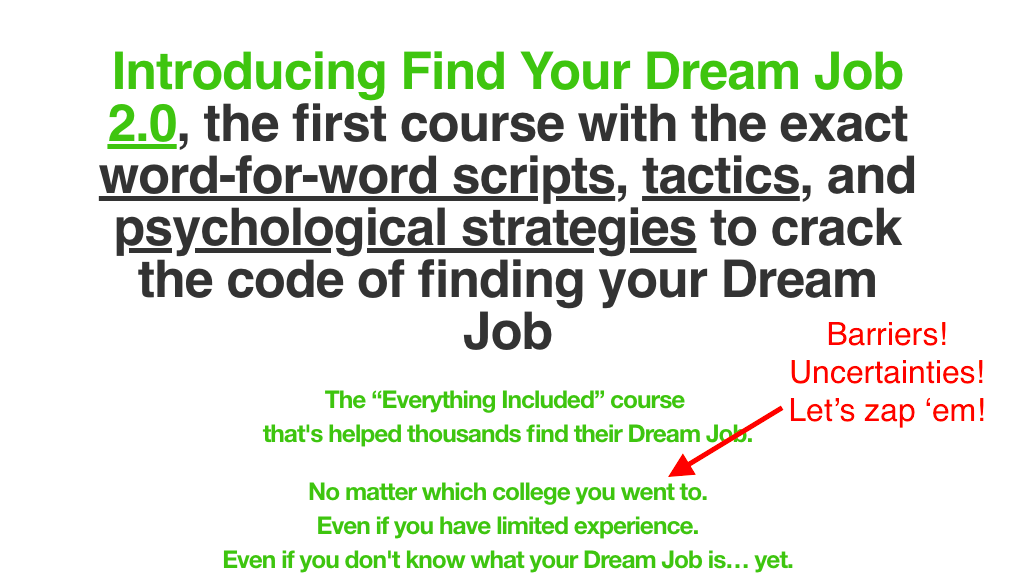
Next, we move on to the Introduction, where we lay out the problem our audience is grappling with in the exact language that we heard them use to describe it themselves:
“I don’t know what my passions are.”
“I don’t have enough experience.”
“I know I’m supposed to network, but I hate selling myself.”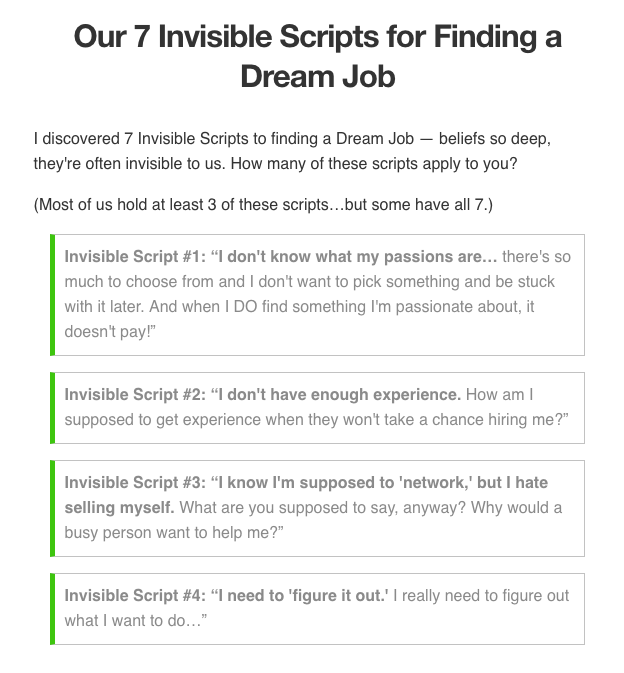
Then, the Offer, where we lay out exactly what we’ve put together to help solve the problem and make the pain disappear. We’re still drawing on the Pains & Fears and Barriers & Uncertainties sections of the Customer Desire Map — the difference is now we’re showing our readers how our product is going to help them conquer those fears, overcome those barriers — and get the results that they’ve been looking for.
- “I’m worried about messing up during the interview” becomes “Instead of fumbling through tough interview questions, you’ll always know the exact words to say — and HOW to say them — for a perfect answer, every time.”
- “I just have to take whatever I get” becomes “Instead of having to take whatever you get, you’ll learn how to negotiate better offers and start bidding wars.”
- “I just have to try harder” becomes “Instead of just ‘trying harder,’ you’ll crack the code behind your psychological barriers and unlock your potential.”
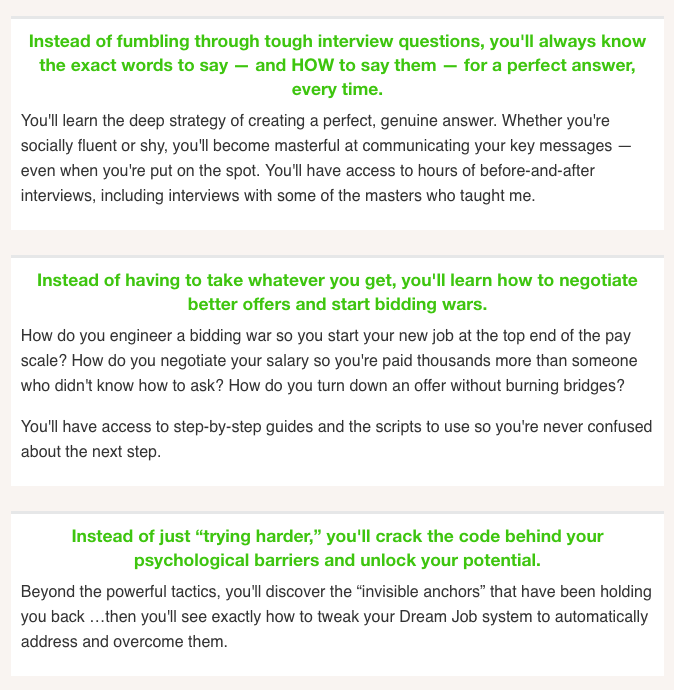
Up next: Price — which, if we’ve done our job right, will be the last thing on our audience’s mind.

If readers are still on the fence after looking at the price, it’s on to Testimonials — where we tap into their Hopes & Dreams by showing them that people have achieved theirs as a result of joining the Dream Job program.
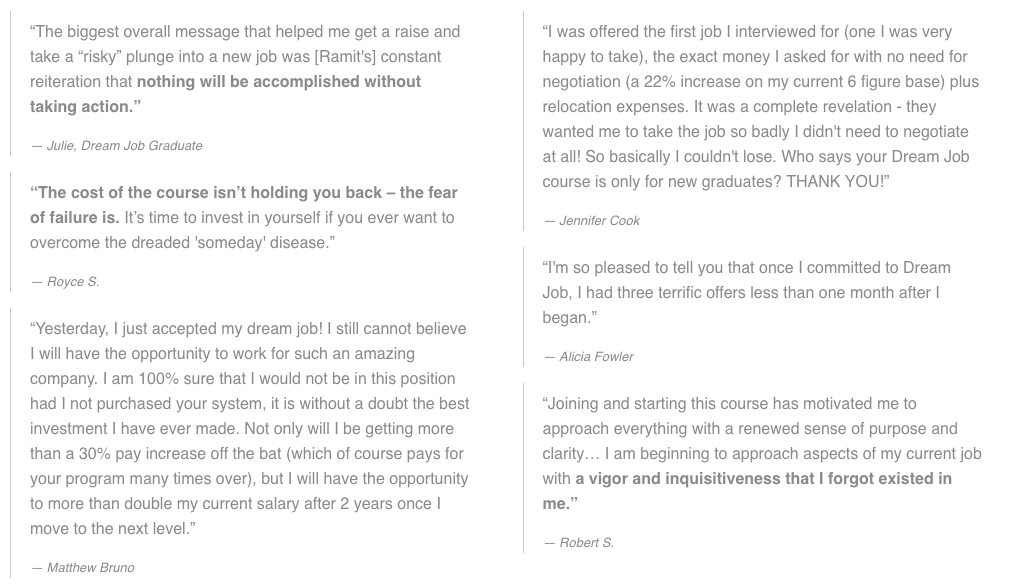
Finally, the Call to action — where we bring it full circle by going back to those barriers and objections that we started with in the headline and challenge people: with everything we’ve shown you in this sales page, are you going to continue to let those obstacles stand in your way? Or are you going to take action and do something to change your life?

Without the Customer Desire Map, we could have spent days and even weeks staring at that template, wondering, What EXACTLY should I say to people in order to show them that I can help them?
But with the Customer Desire Map in hand, there’s no guesswork involved — all the answers we need are right there, waiting.
Landing page: Hit them where it hurts (in a good way)
There are four pieces that good landing pages have in common:
- Headline
- Offer
- Benefits
- Opt-in
Here is a landing page that we used to collect emails from people who were interested in Find Your Dream Job before it opened:
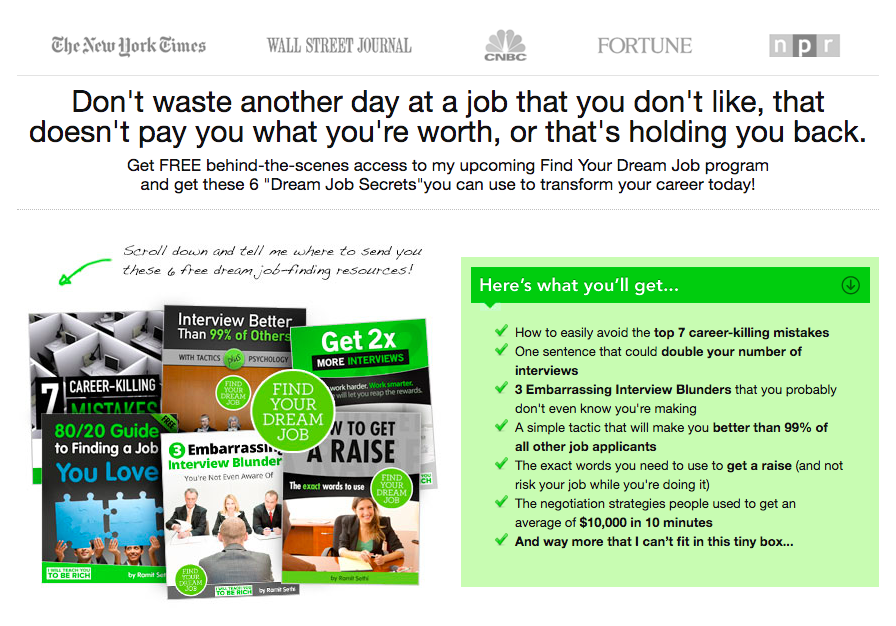
Like with the sales page, we kick things off with an attention-grabbing Headline.
The world wants you to be vanilla...
…but you don’t have to take the same path as everyone else. How would it look if you designed a Rich Life on your own terms? Take our quiz and find out:
“I don’t like my job.”
“They don’t pay me what I’m worth.”
“I feel like my job is holding me back.”
These are all phrases and sentiments that came directly out of customer research. Here, we deploy them with a simple but effective rhetorical twist: Don’t let this be you.
Next, we move on to our Offer, where we lay out some of the awesome material we’ve developed to help neutralize those fears and anxieties, overcome barriers and objections, and get our customers closer to the Dream Job they’re hoping and dreaming about :
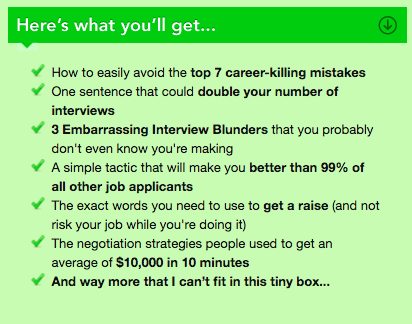
And finally, we land on the Opt-in, which is all about giving people the chance to claim those resources by inputting their email (with a gentle reminder of what’s at stake).
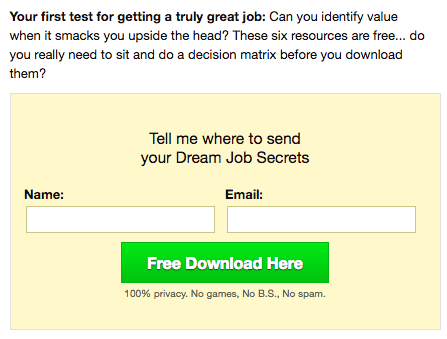
Sales email: Paint a picture of the problem — and provide the solution
Having experimented our fair share with email structure over the years, here’s the one outline we’ve found is the most effective at getting our audience to open, read, and click through on our emails:
- Subject line
- Personal greeting
- An opening line
- Some interesting story or lesson
- A call to action — what do you want the reader to do?
- Personal signoff
- A P.S.
As for how the ideas from the Customer Desire Map come into play? Let’s use this email from the latest version of the Dream Job sales funnel as an example.
We start off with an attention-grabbing Subject line. In this specific case, we’ve kept it pretty straightforward — just an announcement that Dream Job is open and accepting enrollments. But since readers have been hearing about Dream Job for a while now, at this point in the funnel they’re ready, and we can get right down to business.

(Here’s an example of a subject line from earlier in the funnel, where we first teed up the idea of “settling” that we’re bringing back now.)

Up next, a Personal greeting in the name field that sets the tone upfront: this is a personal conversation — I want to talk to you one-on-one.
P.S. Want to really blow your readers’ minds? Drop their name in a few other spots in the body of the email as well (make sure it makes sense in the flow of the copy).
We did that with a recent email — and it didn’t go unnoticed.

Next, we dive into the body of the email with an Opening line that grabs the reader’s attention and gets them interested in what the rest of the email will reveal.
One of our favorite techniques for writing surprising, unexpected sales emails is to go off topic — start the email off with a story that illustrates the point we’re trying to make — but does it in a fun, offbeat way that takes the reader by surprise.
In this email, we’re starting with a story about our CEO Ramit’s friend’s bad relationship … but we’re using it as a sneaky backdoor into the Customer Desire Map idea that we’re interested in exploring: the idea of settling.
From there, we dig into the Story or lesson we want our readers to get out of this unexpected journey we took them on. In this case, it’s this: You don’t have to settle. You CAN find your Dream Job — and we can show you how.
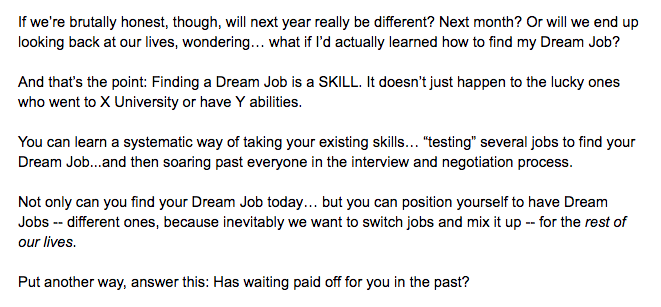
Finally, we get to our Call to action, where we invite people to click through to the sales page to learn more about what Dream Job can do for them. Even here, where all we’re trying to do is get readers to click the link and go to the sales page, we’re still drawing on emotions and mindsets that we heard from students:
"What if there ISN’T a Dream Job for me?"
"What will my parents think after spending all that money on my education?"
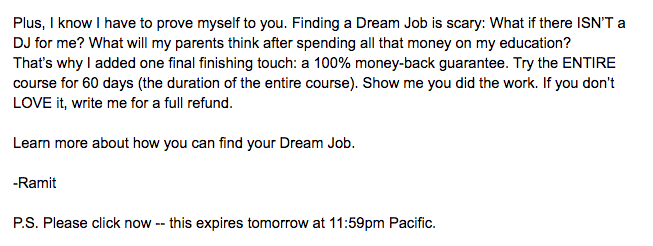
After that, it’s a Personal signoff to remind folks that there is an actual person behind this product, not just a nameless corporation (people buy from people), and a P.S. to remind them there’s a limited time to act.
Useful link: Get our Ultimate Guide to Email Copywriting
P.S. What’s better than ONE sales email? A whole bunch of sales emails! Sales emails don’t happen in a vacuum — they’re part of a funnel, a series of emails that take the reader on an emotional and intellectual journey. Destination: ready to buy.
Useful link: Learn more about our approach to designing 6- and 7-figure email funnels
Blog post: Take one fear or obstacle and dismantle it
Blog posts are a great way to serve your audience a tasty, tantalizing bite of what you’re serving … and get them coming back for seconds, thirds, and the whole damn cake.
As far as the template, we’ve found that a simple, three-step structure works best:
- The hook
- The meat
- The call to action
As an example, let’s look at one of the blog posts we wrote in connection with Find Your Dream Job: How to use Natural Networking to connect with anyone.
In this post, we tackle one of the big items under “Fears & Anxieties” in the Customer Desire Map: “I know networking is important, but I feel fake.”
It starts with the Hook, where we grab the reader’s attention by going after the boilerplate career advice to “go out there and network” — and tear it down in a way that makes clear right off the bat: we know you think networking is annoying and pointless — and we’re on your side.
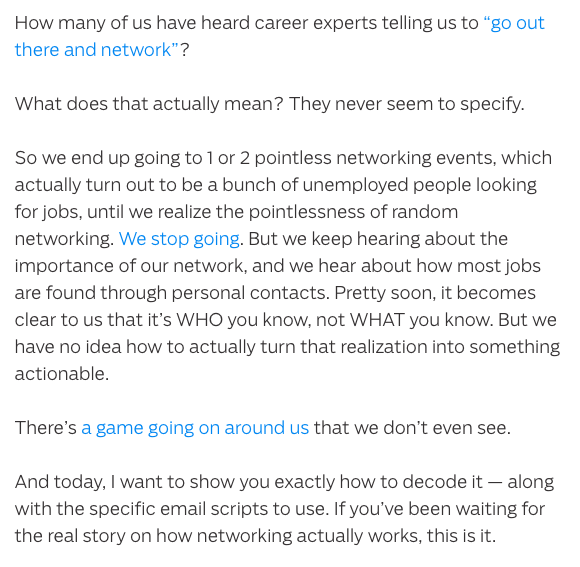
Once we’ve teed up the problem that we know our audience is struggling with, it’s time to move into the Meat, and hit the reader with our solution. In this case, it’s an alternative to the “sleazy’ interactions most people think of when they think of “networking.”
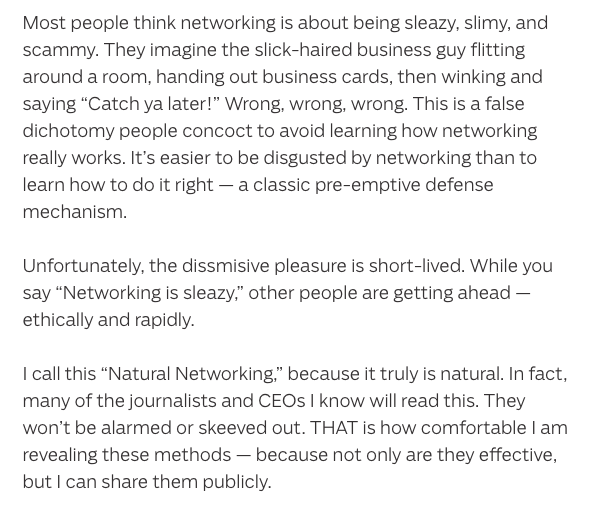
We call our solution “Natural Networking,” and that’s not an accident — it’s a direct response to what we heard from customers we talked to: that networking feels awkward, transactional, sleazy.
We don’t stop at describing Natural Networking, though — we break the process down into clear, actionable steps that our readers can try themselves.
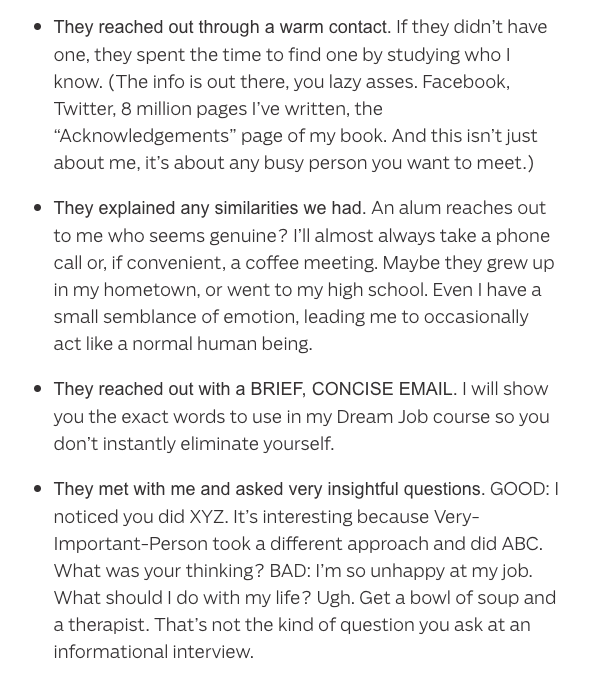
Finally, we wrap up with our Call to action. This is where we give people a homework assignment to do: go and try these techniques for yourself, and see what happens.
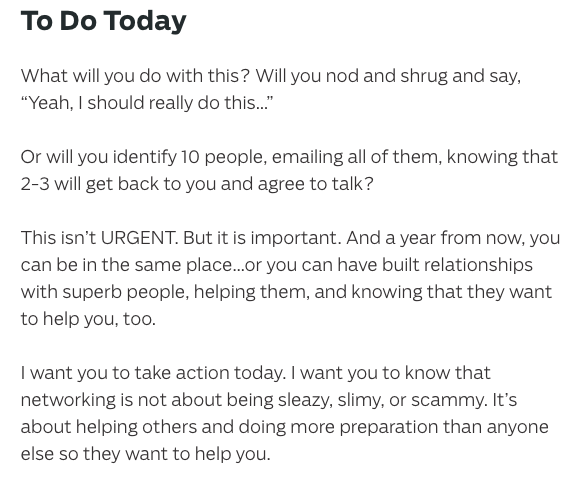
All our readers have to do is follow the steps. And when they do follow the steps, and it works, they’ll come back for more advice on what to do next — and we’ll be ready with a landing page, an email funnel, and a sales page when they do.
Level up your copywriting skills
There you have it: four different varieties of sales materials, all of them built off the foundation of the Customer Desire Map and the actual words that we heard our audience using.
And there’s much, much more where that came from. A thoroughly completed Customer Desire Map can produce dozens of different sales pages, landing pages, emails, and blog post ideas — all of them guaranteed to resonate with your audience, because your audience is the one who told you to write about those things in the first place.
Your customers deserve better than boilerplate platitudes and dime-a-dozen turns of phrase. Your business deserves better.
We’ve shown you how a Customer Desire Map can help you hone in on the exact ideas you should communicate by helping you get crystal clear on your audience’s:
- Hopes & Dreams
- Pains & Fears
- Barriers & Uncertainties
But there’s much more to learn — and we can show you, starting with this video on creating mouth-watering copy (without writing a single word).
If you liked this post, you’d LOVE my Ultimate Guide to Remarkable Content
It’s one of the best things I've published, and totally free – just tell me where to send it: